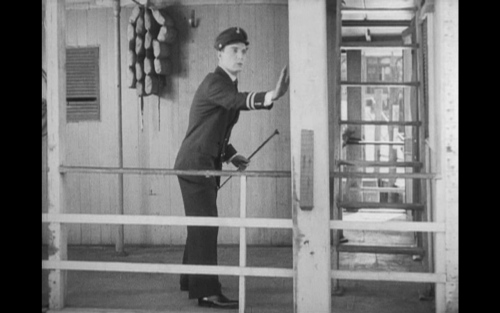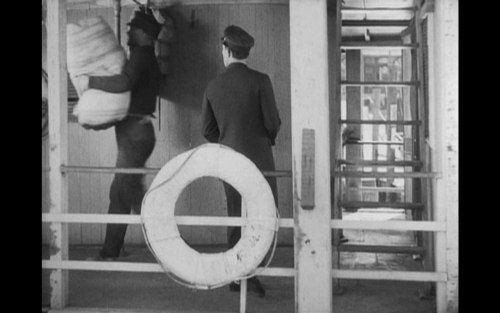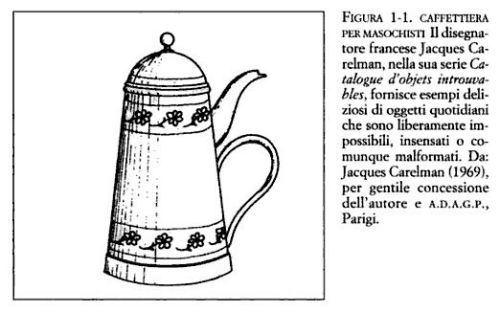What is this disconcerting antipathy glimpsed when everyday objects malfunction or break-down and seem, darkly, to want to hurt us? Evan Calder Williams tracks back the hatred to its origins in production
In Buster Keaton's film Steamboat Bill, Jr. (1928), having de-dandified (mustache and beret removed, and 'work clothes' donned), the prodigal son Bill Jr. comes aboard his father's ship for gainful employ and to acquire the designation Steamboat Bill Jr.

But the objects aren't having it. Moments after stepping on, Bill backs into the railing, knocking the life preserver ring into the river below, where it's expected to bob, cheerily buoyant. But at which point it sinks, like a stone, dragging itself, and the phantom body it would hold aloft, to the muddy cold of the riverbed.
There have been hints, earlier on in the film, of an object world at odds with those who, as a species, make those objects and, as individuals, try to make them work for them. We see a ceaseless series of possible 'mature' hats incapable of pleasing both father and son. But, when compromise is found/forced upon Bill, the wind snatches it away. Wasted time and judgment, spent money, a lost thing. These, however, are minor, invigorating inconveniences. Besides, how else do you develop a bit of character if not tussling with a resistant order of things?
But Steamboat Bill's encounter is something different, revealing a fundamental wrongness of objects. After the ring plummets, Bill steps back in shock, staggering, reaching out to touch the surfaces of the ship, now utterly uncertain what it is, this thing built from money and intended to generate more of it. The assumed correlation between the intended purpose of objects and their actual behaviour shattered in the fall of a single murderous example. For what is a life preserver that isn't just sub-par at preserving life but reveals itself as the promise of death? As a stone life-terminator ring? What is a steamboat if not a ghost ship of sharp edges and weight, inertia and speed and obstinacy? And beyond that vessel, a bristling world barely held together. We touch it gingerly, never knowing what will break and what will break us, thoughtlessly.
This is an instance of what I'll call hostile objects: a conviction that the objects of capitalism aren't just indifferent to us or darkly coherent beyond our intentions.1 They are structurally hostile, and, more often than we'd like to admit, locally hostile: uncertain, unstable, loathing or loathsome, dangerous, and weirdly incommensurable with the purpose for which they were designed. This isn't to speak of nature per se, not an Algernon Blackwood-esque thought of a savage animism.2 Nor is it a unified theory of what the world would be without us even as we still are in it; the dark and threatening woods. For my concern is not 'what is without us', but the shitty flashlight we carry through those woods, the kicking-back chainsaws we wield to take them down. This is an Unnaturphilosophie, concerned not with humanless ecologies but the self-sabotaging, crumbling inhumanity at the core of the economic.
In other words, there is the cold neutrality of that which needs us not a whit (comets, slimes, very old rocks, the usual suspects). And then there's that which would not exist without us or which would not exist as such, and which, if it did or does retain any affective traces of how it came to be, hates us for this fact and scorns its own dependence on the regime of value that ordered its production. As noted, this concern is with objects specific to the historical order of capitalism, whether they be produced as commodities, 'discovered' and valued as potential commodities, or discredited as that which cannot be exchanged. However, insofar as we consider the specificity of capital, it lies not in the older fact of producing goods to be sold, not the commodification of things, but above all the commodification of human labour under the general abstraction of value. In other words, it is the developing global condition by which human effort, broken up into units of time, becomes measurable, quantifiable and exchangeable in terms of the very abstract value it produces: the labour that produces surplus value, and hence drives the whole enterprise, is structured in accordance with the form of value.3

This relation of equivalence opens onto the basic struggle at the heart of the labour and social relations of inequivalence that alternately supports or threatens its smooth running.4 At this level, however, this form of relating, combative as it may be, is not hostility, at least insofar as we intend by hostility something distinct from enmity or antagonism, which implies having a recognisable antagonist.5 Hostility indicates an impersonal, total enmity, a rejection of talking it out, an opaque threat whose motives, source and structure remain ultimately unknowable. The hostis is that which does not belong to - and cannot be understood in accordance with - the order it threatens.6
As such, this hostility - as particular antagonism transformed into threat to the system of values it opposes - emerges along with the general abstraction of labour as capitalism develops, such that the commodity appears outside of the process of production, not just as a finished product of labour, not just as an 'object' to whatever labourer/subject was involved in its production, but as the object of a general order of valuation, circulation, accumulation, and exchange. Broadly speaking, a process of reification: the 'distortion' of conceiving of commodities in terms of social relations and of social relations in terms of commodities. Commonly, we assume that part of the solution is to pull the wool from our eyes, to stop treating objects as subjects and endowing them with social characteristics. Things are just things, they won't make you a better person, they have no inherent social value, destruction of property isn't really violence... But to do this is simply to pass them off as not us, without recognising that they are the material organisation of all the toil, struggle, and negative affect that went into them, that thwarted, pissed-off agency, a clenched fist that keeps pulling punches and punching clocks. Moreover, reification implies that there's a category error, 'socially necessary' but a fallacy all the same, as though something's gone wrong in cognition. But it hasn't. Something has gone wrong in the organisation, production, and maintenance of things. This is no pathetic fallacy, for it's not just that we constantly confront the world of commodified objects as a world of social relations. It's that we confront that world of commodified objects as a hostile world of social relations of hatred, coercion, competition, boredom, emiseration, and exploitation. The entire built world of capitalism is a literal record of hate, drudgery, longing, and withheld explosions, stacked millions of hours high. And it is that which surrounds us, at all moments.
To speak of hostile objects is to speak of two distinct modes.
General hostility: as described above, the structural condition of how enmity is abstracted into the relation of general equivalence that underpins the value-form and is therefore a characteristic of all commodities. It is a hostility not present 'in' an object as a supplement or a remainder, but rather in the basic relation between commodities of which human labour - and all its supplementary work of reproducing itself, buying commodities, moving around, sitting in buildings - is one.7 Such hostility is not apparent in normal interactions of exchange and use, and it does not 'cause' those instances of threat. Rather, in the normally intolerable state of affairs, it takes an exceptional failure for such an encounter with the base toxicity of the value-form to come into view: not just when something breaks down in an expected manner and after a socially reasonable amount of time but when active intervention (sabotage) or a strange, inexplicable failure (auto-sabotage) turns a commodity into 'just an object' of busted value before it ‘was its time to go'.
Particular hostility: Distinct instances of objects whose relation to those using them, or in proximity, appears distinctly malevolent, counter-productive, and weird. Whether or not this is attributed to chance, some lasting trace of the particular circumstances of an object's production, or, in the often fantasmatic cultural instances I consider here, some volition, appears to direct it. There is something particular about this thing that acts in a manner that cannot be understood in terms of its intended function yet which appears to have it in for us.8

Capitalism is ultimately predicated on a crossing back and forth between the general and the particular, with the aggregate measure of the latter giving shape to the former, and with the injunctions of the former dictating the available modes of latter. Here, too, any rigid division misses the point. Of greater interest is where the point of crossing between the two becomes a sticking point, where such a constantly self-reinforcing real abstraction runs into blockages. One of these blocked crossings is sabotage, in which the insupportable contradictions of work are brought to bear directly on its own processes.9
In 1916, Elizabeth Gurley Flynn, an American Wobbly, wrote a short pamphlet entitled Sabotage: The Conscious Withdrawal of the Workers' Industrial Efficiency, a remarkable and seriously under-read document whose topics range from over-salting the soup to birth strikes.10 Her innovation, similar to Marx's understanding of how creative destruction and crises are necessary for the health of capitalism, is to see sabotage not only as something done against capitalism. Rather:
Employers interfere with the quality of production, they interfere with the quantity of production, they interfere with the supply as well as with the kind of goods for the purpose of increasing their profit. But this form of sabotage, capitalist sabotage, is antisocial, for the reason that it is aimed at the good of the few at the expense of the many, whereas working-class sabotage is distinctly social, it is aimed at the benefit of the many, at the expense of the few.
Of course, given the sheer amount of waste and rot capital generates on its own, it's unlikely that communist disruption can come anywhere close to the potlatch of everyday circulation. Understandably, then, Flynn moves, in this sabotaged dialectics,11 toward the interference in quality with particular emphasis on adulteration ('the act of debasing a pure or genuine commodity for pecuniary profit, by adding to it an inferior or spurious article, or by taking from it one or more of its constituents').12 The specific instance that provoked this pamphlet was the arrest of Frederic Sumner Boyd for encouraging sabotage in a textile mill and urging workers to use certain chemicals in the dyeing of the silk that would make it unweavable. Yet, as Flynn points out, 'these chemicals are being used already in the dyeing of the silk. It is not a new thing that Boyd is advocating, it is something that is being practiced in every dye house.' In short, Boyd's sabotage consists of adding just a bit more of the chemicals already used in the factories by capitalists who willfully debase the quality of their own silk, in order to make it accord with a different principle of valuation, that of weight.13
The silk is there. The loom is there. There is no property destroyed by the process. The one thing that is eliminated is the efficiency of the worker to cover up this adulteration of the silk, to carry it just to the point where it will weave and not be detected. That efficiency is withdrawn.
And what is drawn out, at the moment where the silk passes from potentially exchangeable to a ruined bolt of metal-soaked junk, is the hostility of the general structure, as the real movements of exchange are made manifest and manifest themselves as generally hostile. We might take Alfred Sohn-Rethel's point that the act of exchange is an act of practical solipsism: 'mine - hence not yours; yours - hence not mine. What is reciprocal is the exclusion of ownership.'14 Yet against these rival claims, the commodity is posited as one, a unity imagined outside of processes of change and effects of decay or interference. At the moment of exchange, it is withdrawn from consideration of use or change: 'they are equated by virtue of being exchanged, they are not exchanged by virtue of any equality which they possess.' And so sabotage is the mirrored moment of exchange, a withdrawal of a commodity from circulation but via the utter destruction of the supposed utility, and hence exchangeability, of that thing. It declares this is no one's, with a jerking halt in the circuit. If we can't all own it, can't all profit from it, and, above all, can't all not make it in the first place, then no one will have it. It is a deictic, negatively social act waiting in the anti-social wings of accumulation.

What, though, of our stone life preserver? What of that possibility that rears its head into the plane of the normally functioning, of particular hostile objects, not broken in order to fight against a regime of work but a sabotage unmanned, unnamed and deeply strange? If one point of this project is to develop a sense of the hostility there from the start, which we might access through acts of intervention or research, the other is to consider just how difficult it is to provide figuration of such an asubjective malevolence. In this regard, I want to end with a gesture toward a cultural history, a project to come, of scattered instances across the 20th century that have grappled with this very problem and whose 'failure' to get it right has produced a volatile, unsettling trajectory of haunted houses, possessed appliances, squirming neckties itching to become nooses, slippery floors, and explosive fraying fabric. One could write a history of real commodities that have shown themselves distinctly capable of this strange enmity: after all, we exist in a world that has produced automated dolls intended to chomp away on play food and which have turned instead on the hair of little girls, eating their way relentlessly toward the scalp. Here, however, I offer a skeletal outline of some of instances that have given full reign to that darker prospect of objects genuinely out to get us. The majority of the examples here are from film. This not accidental: as a mode of production, as a temporal medium, as a site of special effects capable of, and taking pleasure in, showing objects act 'of their own accord', as that born of the moment of assembly line and the massive changes in social composition this wrought, as the most extended elaboration of the horror genre in which one would expect to find badly behaving objects, as commodity, and as that art form which perhaps most bears the traces of the entire cultural-industrial assemblage that lies behind any singular instance of 'popular cinema', film has been best suited to this task, all the more so in how it butts against these impasses of thinking hostility.
In 1928, the same year as Steamboat Bill, Jr., Hans Richter's Ghosts Before Breakfast, whose air of whimsy can't suppress its stench of menace, as revolvers turn unbidden and hats swoop free of their heads as though The Birds had been about men's fashion.
In Russia, Soviet novelist Andrei Platonov's lumpen animism perhaps leaves behind the commodity as such, but paints the obduracy, rot, and valueless heart of things so viciously that its rubbish wind can't help but blow west.
Botanical illustrations of cables in Italy show them unwinding themselves, a frayed hack at its own behest, far before fiber optics snake through the ground.
The second World War, and the RAF pilots' fantasies of gremlins. In the US, they laugh this off and make cartoons about it, turning the gremlins into supplementary, external homunculi, alternately hammering away at bombs and sawing away at Hitler's bomber. This is a safety measure, a defanged fantasy, keeping the actual fact of worker's loathing out of the rivets and converting it into a recognisable anthropic form that comes from outside to wreak playful havoc on the deathly machines.
1951's The Man in the White Suit, a whirling mess of an anti-work film, in which capital and organised labour unite against the threat of a fabric impervious to decay and dirt, a white polymer that nearly takes down the factory in a recurrent series of explosions and which ultimately takes itself down, into handfuls of useless chaff.15
Tati's films, not because ultra-modern kitchens prove seriously harmful to one's health, but because they paint a moment caught between two poles: poisonous, spring-loaded plastic, or the bombed-out detritus of a dead world.
Guy Debord's reminder that 'wreckers write their names only in water': sabotage may have its agents provocateurs, but what remains is nothing but the restless fact of the devalued.
Jacques Carelman's Catalogue d'objets introuvables and its masochistic teapots, inverted tandem bicycles built so that lovers will strain headlong against each other, and visions of objects flawlessly redesigned to express the vicious potential they had all along.
Closer to the present, the clarification that although the generic convention of hostile objects should be horror, the horror film has proven itself most incapable of thinking enmity without a locatable subject. Instead the genre tends either to orchestrate the hostis from behind the scenes as discernible antagonist or present it to be demonically stuck in the things themselves, even as it has given us an endless series of dish-smashing spooks, furious toys, and machines with minds of their own. It comes closest, perhaps, in the physical spaces of Dario Argento's giallo horrors, in which the modern landscape is shown to consist, above all, of an excess of highly polished sharp things against which bodies prove to be little more than overfull containers of bright red liquid. But where it seems it should be the case, in tales focused on commodities, it can't shake off the specter of the anthropic. John Carpenter's Christine certainly provides a retributive car, possessed by no one, that responds murderously to men putting their hands under its hood, yet it frames this under the sign of a jealous woman competing for the affection of her owner. Tobe Hooper's The Mangler begins remarkably, something like a Heiner Müller horror-of-labour tale, with appropriately throwback factory aesthetics centered around its hulking, blood-thirsty steam press, but it's only a matter of time before it unfolds into a story of the demon that impels it. The Final Destination series, in all its Rube Goldbergian glee, betrays the latent possibility of an unending set of dangerous chain reactions without a planner behind the scenes. For even without literally anthropomorphising death, it does insofar as it sets up a situation in which the protagonists cheated death out of the predetermined selection of their time to go, and hence this inventive malevolence of the object world is an exception dictated by a retributive need to set the order right.16 Various Japanese horror offerings turn banal commodities - cell-phones, hair extensions - into harbingers and deliverers of doom, but inevitably, there's a literal ghost in the shell, lashing out and righting past wrongs. Even the immaterial hell-raiser of Joe Dante's Gremlins 2: The New Batch, which is nothing more than electrical current, shows itself to us in a neon approximation of that familiar bat-eared gremlin shape, proving that a shift from an aesthetics of mass produced things doesn't ensure a break in the demand that there be some one to blame for all this mess.

To return to where we started, comedy, particularly of the slapstick variety, has proven itself the strongest site for wrestling with the potential violence of these everyday products of capital's structural violence. And so, in a strange reversal, while horror ends up venturing an essentially comedic question (what if my hair-drier was possessed by the angry soul of a teenage girl who killed herself?), comedy edges closer to a legitimately horrifying prospect: what if my hair-drier was possessed by no one yet might destroy me in spite of that fact? No wonder we laugh, and nervously. For inasmuch as we take cultural elaborations as a decent measure of the limits of what we can grasp or imagine, then we don't know how to think antagonism without a protagonist, hostility beyond subjects. That is, we don't know how to think one of the basic conditions of capitalism nor any sabotage incorporated by or directed against it. And this is the case no matter how many railroad tracks we undo, soups we spoil, bolts of silk we ruin, windows we shatter, or life rings that take us with them straight to hell.
Evan Calder Williams is a writer living in California and author of Combined and Uneven Apocalypse, forthcoming from Zero Books this spring. He writes the blog Socialism and/or Barbarism
This piece is indebted to suggestions from, and extended conversations with, a number of people, especially Giovanni Tiso, Jannon Stein, Marina Vishmidt, and to two events hosted, alternately, by Benjamin Noys and Pil and Galia Kollectiv
Footnotes
1 This will become clearer in the piece, but a brief note on why hostile objects, instead of hostile commodities. The reason is that the moment when such a hostility - either in its general form of the exchange abstraction or in a form particular to that commodity - becomes manifest, intrusive, or apparent is the moment of the assertion of an object against its limitation to being just commodity.
2 Or rather, an agential, often anthropomorphic (even as it tries to disavow the humanness of what it depicts), monstrous nature.
3 This is Marx's central point about the real, as opposed to formal, subsumption of labour under capital.
4 Following a line of analysis associated with Mario Tronti and other workerist thinkers, without necessarily agreeing with their general approach, we can say that worker's struggle is itself both a support and a threat. Because workers refuse the simple extension of working hours or the decrease of wages, capital is forced to innovate in order to continually grow, thereby developing new technologies of fixed capital, modes of consumption, financial instruments, and all other arcane paraphernalia of capitalist accumulation. Of course, the prospect always remains, however rare, that workers will not just try to defend their right to work and the tolerable quality of that work but begin attacking the very categories of work and worker.
5 As is initially the case in most labour formations (a discernible hierarchy of lords and bosses) and remain so in many, with the distinctly personal and enclosed situations of boss-workers, in all its local dynamics and inheritances from "pre-capitalist" modes.
6 For example, to be designated a hostis humanis generis (the enemy of all mankind), as pirates were, is to be designated as no longer belonging to the mankind you threaten: you become a barbarian to the species, that of a different order of knowledge and value. For more on hostility and opacity, see my previous article in Mute: 'Painting the Glass House Black', 25 March 2010, http://www.metamute.org/content/painting_the_glass_house_black
7 This might be understood as the flip-side of the general intellect Marx sees crystallized in the machinic assemblages of production and circulation.
8 N.B., for the sake of this piece, I am not considering another major version of what might be meant by particularly hostile objects, namely, those designed to be that way. I'm leaving out the most hostile of 20th century objects, military technology, partly because as against that which fires flawlessly and lethally, I'm interested in misfirings. Not in just what kills or what goes wrong (not something that wears out as expected, not the fact that a sharpened knife might cut you if misused or that a badly designed chair will fuck up your back), but what goes weirdly wrong, against expectation.
9 In this space, a longer account of sabotage is far beyond me. However, this text is a glancing version of my conviction that sabotage is perhaps the key basic concept by which to understand what any form of fighting back will look like. This doesn't mean that the prime task of the day is to stick more metal wrenches between more metal gears, or to 'go slow' by stealing more work time on Facebook. Rather, in the face of an overwhelming collapse of much of what constituted the 'legit' organised prole battles, sabotage becomes both a particular injunction and a diffuse condition. It will not necessarily ‘look like' sabotage.
10 http://www.iww.org/culture/library/sabotage/
11 Sabotage as an 'internal process' that ruptures the passage from quantity (hours, goods made) to quality (the coherence of the system's persistence).
12 http://www.1902encyclopedia.com/A/ADU/adulteration.html
13 This is called 'dynamiting the silk', weighting it with solutions of tin, solutions of zinc, solutions of lead, such that, as Gurley Flynn writes in one of the more striking passages of the text:
And so when you buy a nice piece of silk today and have a dress made for festive occasions, you hang it away in the wardrobe and when you take it out it is cracked down the pleats and along the waist and arms. And you believe that you have been terribly cheated by a clerk. What is actually wrong is that you have paid for silk where you have received old tin cans and zinc and lead and things of that sort. You have a dress that is garnished with silk, seasoned with silk, but a dress that is adulterated to the point where, if it was adulterated just the slightest degree more it would fall to pieces entirely.
14 Alfred Sohn-Rethel, Intellectual and Manual Labour: A Critique of Epistemology, Humanities Press, 1983.
15 For an extended analysis of this film, see 'It's just the suit. It looks as if it's wearing you', Socialism and/or Barbarism blog, http://socialismandorbarbarism.blogspot.com/2010/06/its-just-suit-it-looks-as-if-its.html
16 However, it does provide a strangely military, or secret agent mode of surveying the hostile territory, where each thing in an area is not read in terms of the degree to which it serves its prescribed purpose or is a store of exchange value, but rather in terms of how it might cut, burn, crush, puncture, electrocute, or otherwise maim you. And as it turns out, there is much in the built world capable of doing this. We owe the film for giving a tanning bed the chance to finally bare its glowing blue teeth.















